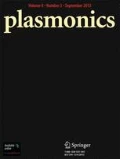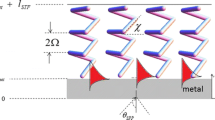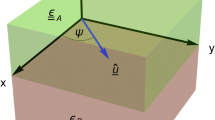Abstract
Excitation of multiple surface plasmon-polaritons (SPPs) by an equichiral sculptured thin film with a metal layer defect was studied theoretically in the Sarid configuration, using the transfer matrix method. Multiple SPP modes were distinguished from waveguide modes in optical absorption for p-polarized plane wave. The degree of localization of multiple SPP waves was investigated by calculation of the time-averaged Poynting vector. The results showed that the long-range and short-range SPP waves can simultaneously be excited at both interfaces of metal core in this proposed structure which may be used in a broad range of sensing applications.










Similar content being viewed by others
References
Polo JA, Lakhtakia A (2011) Surface electromagnetic waves: a review. Laser and Photonics Rev 5(2):234–246. https://doi.org/10.1002/lpor.200900050
Swiontek SE, Pulsifer DP, Lakhtakia A (2013) Optical sensing of analytes in aqueous solutions with a multiple surface-plasmon-polariton-wave platform. Sci Rep 3(1):1409. https://doi.org/10.1038/srep01409
Pulsifer DP, Lakhtakia A (2009) Multiple surface plasmon polariton waves .Electron Lett 45:1137–1138. https://doi.org/10.1049/el.2009.2049
Mackay TG, Lakhtakia A (2012) Modeling chiral sculptured thin films as platforms for surface-plasmonic-polaritonic optical sensing. IEEE Sensors J 12(2):273–280. https://doi.org/10.1109/JSEN.2010.2067448
Motyka MA, Lakhtakia A (2008) Multiple trains of same-color surface plasmon-polaritons guided by the planar interface of a metal and a sculptured nematic thin film. Journal of Nanophotonics 2(1):021910. https://doi.org/10.1117/1.3033757
Faryad M, Lakhtakia A (2011) Grating-coupled excitation of multiple surface plasmon-polariton waves. Phys Rev A 84(3):033852. https://doi.org/10.1103/PhysRevA.84.033852
Robbie K, Brett MJ (1997) Sculptured thin films and glancing angle deposition: growth mechanics and applications. J Vac Sci Technol A 15(3):1460–1465. https://doi.org/10.1116/1.580562
Robbie K, Sit JC, Brett MJ (1998) Advanced techniques for glancing angle deposition. J Vac Sci Technol B 16(3):1115. https://doi.org/10.1116/1.590019
Robbie K, Brett MJ, Lakhtakia A (1996) Chiral sculptured thin films. Nature 384(6610):616. https://doi.org/10.1038/384616a0
Hodgkinson IJ, Lakhtakia A, hong Wu Q, Silva LD, McCall MW (2004) Ambichiral, equichiral and finely chiral layered structures. Opt Commun 239(4-6):353–358. https://doi.org/10.1016/j.optcom.2004.06.005
van Popta AC, Brett MJ, Sit JC (2005) Double-handed circular Bragg phenomena in polygonal helix thin films. J Appl Phys 98(8):083517. https://doi.org/10.1063/1.2115092
Mackay TG, Polo JA, Lakhtakia A (2013) Electromagnetic surface waves: a modern perspective. Elsevier, Waltham
Faryad M, Lakhtakia A (2011) Propagation of surface waves and waveguide modes guided by a dielectric slab inserted in a sculptured nematic thin film. Phys Rev A 83(1):013814. https://doi.org/10.1103/PhysRevA.83.013814
Krenn JR, Weeber J-C (2004) Surface plasmon polaritons in metal stripes and wires. Phil Trans R Soc Lond A 362:739–756 https://doi.org/10.1098/rsta.2003.1344
Sarid D (1981) Long-range surface-plasma waves on very thin metal films. Phys Rev Lett 47:1927–1930 https://doi.org/10.1103/PhysRevLett.47.1927
Sarid D, Challener WA (2010) Modern introduction to surface plasmons: theory, Mathematica modeling and applications. University Press, Cambridge. https://doi.org/10.1017/CBO9781139194846
Berini P (2009) Long-range surface plasmon polaritons. Adv Opt Photon 1(3):484. https://doi.org/10.1364/AOP.1.000484
Lakhtakia A, Messier R (1997) Sculptured thin films - I. Concepts. Mater Res Innov 1(3):145–148. https://doi.org/10.1007/s100190050032
Messier R, Lakhtakia A (1999) Sculptured thin films — II. Experiments and applications. Mater Res Innov 2:217–222 https://doi.org/10.1007/s100190050088
Fuzi Y, Sambles J, Bradberry GW (1991) Long-range surface modes supported by thin films. Phys Rev B 44:5855 https://doi.org/10.1103/PhysRevB.44.5855
Faryad M, Lakhtakia A (2010) Surface plasmon–polariton wave propagation guided by a metal slab in a sculptured nematic thin film. J Opt 12(8):085102. https://doi.org/10.1088/2040-8978/12/8/085102
Polo JA, Mackay TG, Lakhtakia A (2011) Mapping multiple surface-plasmon-polariton-wave modes at the interface of a metal and a chiral sculptured thin film. J Opt SocAm B 28(11):2656. https://doi.org/10.1364/JOSAB.28.002656
Quail JC, Rako JG, Simon HJ (1983) Long-range surface-plasmon modes in silver and aluminum films. OptLett 8:377–379 https://doi.org/10.1364/OL.8.000377
Craig AE, Olson GA, Sarid D (1983) Experimental observation of the long-range surface-plasmon polariton. Opt.Lett 8(7):380–382. https://doi.org/10.1364/OL.8.000380
Dohi H, Kuwamura Y, Fukui M, Tada O (1984) Long-range surface Plasmon Polaritons in metal films bounded by similar-refractive-index materials. J Phys Soc Jpn 53(536):2828–2832 https://doi.org/10.1143/JPSJ.53.2828
Pulsifer DP, Faryad M, Lakhtakia A (2013) Observation of the Dyakonov-Tamm wave. Phys RevLett 111(538):243902 https://doi.org/10.1103/PhysRevLett.111.243902
Hodgkinson I, Hong Wu Q, Hazel J (1998) Empirical equations for the principal refractive indices and column angle of obliquely deposited films of tantalum oxide, titanium oxide, and zirconium oxide. Appl Opt 37:2653–2659 https://doi.org/10.1364/AO.37.002653
Lakhtakia A, Jen Y-J, Lin C-F (2009) Multiple trains of same-color surface plasmonpolaritons guided by the planar interface of a metal and a sculptured nematic thin film. Part III: experimental evidence.J Nanophotonics 3:033506. https://doi.org/10.1117/1.3249629
Gospodyn J, Sit JC (2006) Characterization of dielectric columnar thin films by variable angle Mueller matrix and spectroscopic ellipsometry. Opt Mater 9:318–325 https://doi.org/10.1016/j.optmat.2005.10.004
Mansuripur M, Zakharian AR, Moloney JV (2007) Surface plasmon polaritons on metallic surfaces. Opt Photon News 18(4):44. https://doi.org/10.1364/OPN.18.4.000044
Lakhtakia A (2007) Surface-plasmon wave at the planar interface of a metal film and a structurally chiral medium. Opt Commun 279(2):291–297. https://doi.org/10.1016/j.optcom.2007.07.026
Babaei F, Omidi M (2013) Characteristics of plasmonic at a metal/chiral sculptured thin film interface. Plasmonics 8(2):1051–1057. https://doi.org/10.1007/s11468-013-9508-z
Babaei F, Shafiian-Barzoki S (2014) Surface plasmon polariton propagation at the interface of a metal and an ambichiral nanostructured medium. Plasmonics 9(3):595–605. https://doi.org/10.1007/s11468-014-9670-y
Babaei F, Shafiian-Barzoki S (2014) Surface plasmon polariton modes at interface of a metal and an ambichiral sculptured thin film. Plasmonics 9(6):1481–1489. https://doi.org/10.1007/s11468-014-9767-3
Lakhtakia A, Messier R (2005) Sculptured thin films: nanoengineered morphology and optics. SPIE, USA
Acknowledgements
The authors would like to express their deep gratitude to the University of Qom and Iran National Science Foundation (INSF) for supporting this work.
Author information
Authors and Affiliations
Corresponding author
Appendix A: The Transfer Matrix Method
Appendix A: The Transfer Matrix Method
The transfer matrix of the bottom, top of ECSTFs and metallic thin film can be obtained by solving the source-free Maxwell curl postulates in that regions:
where D and B are the displacement electric and the magnetic induction fields, respectively. The constitutive relations for D and B are as
in lth arm of the ECSTF and
in metal mediums. The εmet is the metal homogenous dielectric permittivity, and the nonhomogeneous dielectric permittivity \( {\underline {\underline{\varepsilon}}}_{ECSTF} \) for lth arm of the ECSTF is defined as [12]
where the superscript T indicates the transpose of a dyadic, ζ = h(l − 1) (2π/Q) − γ, χ is tilt angle of the nanocolumns of the ECSTF,h = + 1(or − 1) is the right-handedness (or left-handedness) of the ECSTF, and γ is the offset angle(the starting point for growth) of the nanocolumns of the ECSTF relative to the x axis in x-y plane. In our work, we fixed ψinc = 0° and the structure rotates in clockwise direction so that it is considered as −γ in the ζ angle (Fig. 1).
The local relative permittivity, rotation, and tilt dyadics are, respectively, as [35]
where εa, b, c are the relative permittivity scalars.
With considering electromagnetic fields in dielectric and metal regions are as follows:
and using Eqs. 5–7, one can obtain four ordinary differential equations and two algebraic equations. The two algebraic equations for ez and hz in ECSTF (for lth arm) and metal mediums are, respectively, as follows:
where A = (ex(z) cos ζ − ey(z) sin ζ) and B = (εacos2χ + εbsin2χ).
The four ordinary differential equations can be sorted as a matrix equation:
where \( \underline{\Big[f}(z)\Big]={\left[{e}_x(z)\kern0.36em {e}_y(z)\kern0.36em {h}_x(z)\kern0.48em {h}_y(z)\;\right]}^T \) is a column vector. The \( \left[\underline {\underline{P}}(z)\right] \) is a 4 × 4 matrix, and the elements of it forlth arm of the ECSTF are
and the other elements are zero. The elements of \( \left[\underline {\underline{P}}(z)\right] \) in metal region are
and the else elements are zero.
We now consider an ECSTF with thickness of d = N t, where t is the thickness of an arm of ECSTF and N is the number of arms. The transfer matrix of a columnar thin film with thickness of t is \( {e}^{i\;\left[\underline {\underline{P}}\right]\;t} \). Therefore, the transfer matrix of an ECSTF is [33, 34]
where \( {\left[\underline {\underline{M}}\right]}_l={e}^{i\;\left[{\underline {\underline{P}}}_l\right]\;t},l=1,2,\dots, N \). Then, this method can be used to obtain the transfer matrix of the bottom and top of ECSTFs in Eq. 3 (\( \left[{\underline {\underline{M}}}_b\right] \) and \( \left[{\underline {\underline{M}}}_t\right] \)). Also, easily, the transfer matrix of metal is just \( {\left[\underline {\underline{M}}\right]}_m={e}^{i\;\left[\underline {\underline{P}}\right]\;{d}_{met}} \).
By rewriting Eq. 1 as \( \left[\underline{f}\right(z=-{\left({d}_b+\frac{d_{met}}{2}\right)}_{-}\Big]=\left[\underline {\underline{K}}\left({\theta}_{inc}\right)\right]{\left[{a}_S\;{a}_P\;{r}_S\kern0.36em {r}_P\right]}^T \) in incident medium (including incident and reflected electric fields) and\( \left[\underline{f}\right(z={\left({d}_t+\frac{d_{met}}{2}\right)}_{+}\Big]=\left[\underline {\underline{K}}\left({\theta}_{tr}\right)\right]{\left[{t}_S\;{t}_P\;0\kern0.36em 0\right]}^T \)in transmitted medium, the nonzero elements of \( \left[\underline {\underline{K}}\left({\theta}_{inc}\right)\right] \) and \( \left[\underline {\underline{K}}\left({\theta}_{tr}\right)\right] \), respectively, are
and
Rights and permissions
About this article
Cite this article
Hosseininezhad, S.H., Babaei, F. Excitation of Multiple Surface Plasmon-Polaritons by a Metal Layer Inserted in an Equichiral Sculptured Thin Film. Plasmonics 13, 1867–1879 (2018). https://doi.org/10.1007/s11468-018-0701-y
Received:
Accepted:
Published:
Issue Date:
DOI: https://doi.org/10.1007/s11468-018-0701-y




